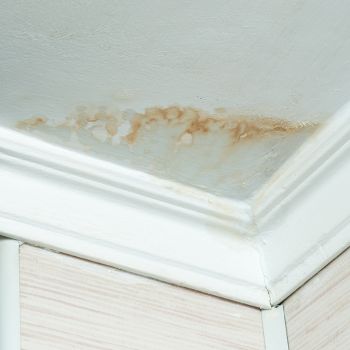How to Address a Leaking Ceiling Pipe
 When you spot water dripping from the ceiling or the remnants of a leak, such as discolored patches or bubbling paint, this scenario can go back to a number of sources. From a damaged roof to poorly draining gutters or a leaking pipe, you’re advised to contact a professional who can best address the issue and prevent the damage from spreading.
When you spot water dripping from the ceiling or the remnants of a leak, such as discolored patches or bubbling paint, this scenario can go back to a number of sources. From a damaged roof to poorly draining gutters or a leaking pipe, you’re advised to contact a professional who can best address the issue and prevent the damage from spreading.
Signs of a Leaking Pipe In Your Ceiling
Your home or apartment may have a leaking pipe passing through the ceiling or a nearby wall if you notice a combination of these signs:
- A musty, moldy smell in the room that never goes away
- Ceiling lights or other fixtures have droplets or pools of water inside
- More insects inside the room
- Bubbling or flaking paint on parts of the ceiling
- Dark, foul-smelling water drips from your ceiling
- Dripping that increases at certain times – for example, after someone uses the toilet
- A leak or water pooling around your toilet’s ring
- Curling or peeling of flooring material around your shower
- Water dripping from your sink that pools on the floor or in the cabinet below
- Damp supply lines to the toilet or another bathroom fixture
If you ignore these signs, damage can spread to your drywall, contribute to a mold problem and start to affect your home’s structure.
Causes of a Ceiling Leak
The source of a ceiling leak may go back to a plumbing problem or roof issue. Here’s how you can narrow down the cause:
- If you spot the ceiling leak on a lower level of your home, damaged plumbing may be the source.
- Check the water supply, which is attached to the toilet or sink trap. You may notice water dripping from a connection between lines.
- If the leak seems to fluctuate between getting better and worse, the issue may be a broken drain pipe.
- Check your roof for signs of a leak. Debris-clogged or poorly angled gutters can divert water over your roof and into your home. Damaged or missing shingles, flashing or an ice dam can also cause water to seep into your attic or the top floor. In these cases, the ceiling of these upper rooms will appear damp and discolored or may have started to rot in certain areas.
What You Can Do
Once you notice a leak or steady drip from your ceiling, take action with the following steps:
- Place a bucket, trash can or other leak-proof container below to catch any dripping water and reduce the spread of mold. Add plastic sheets or another protective covering to any nearby furniture.
- Clean up any moisture already on the floor.
- If you notice a larger bubble, try to create a hole in the ceiling to drain the water and prevent damage from spreading.
- Set up a fan or dehumidifier to reduce condensation.
- Attempt to trace the leak in your home to a pipe, fixture or the roof. Note the presence of multiple leaks or damp spots.
- Don’t forget about light fixtures; see if water is pooling in these areas.
- Check if dampness has started to spread throughout your home, including to the insulation, cabinets and drywall.
- If you suspect a plumbing leak, shut off a valve to prevent water from flowing to the affected pipe. You may also need to temporarily stop using the water in your house to halt the spread of damage. Cracking, sagging or crumbling drywall is a sign that your ceiling may collapse.
If you suspect a leaking pipe, don’t wait to address the damage. Contact MJ Fahy & Sons to have our team of plumbers identify the cause and repair your pipes or fixture.




